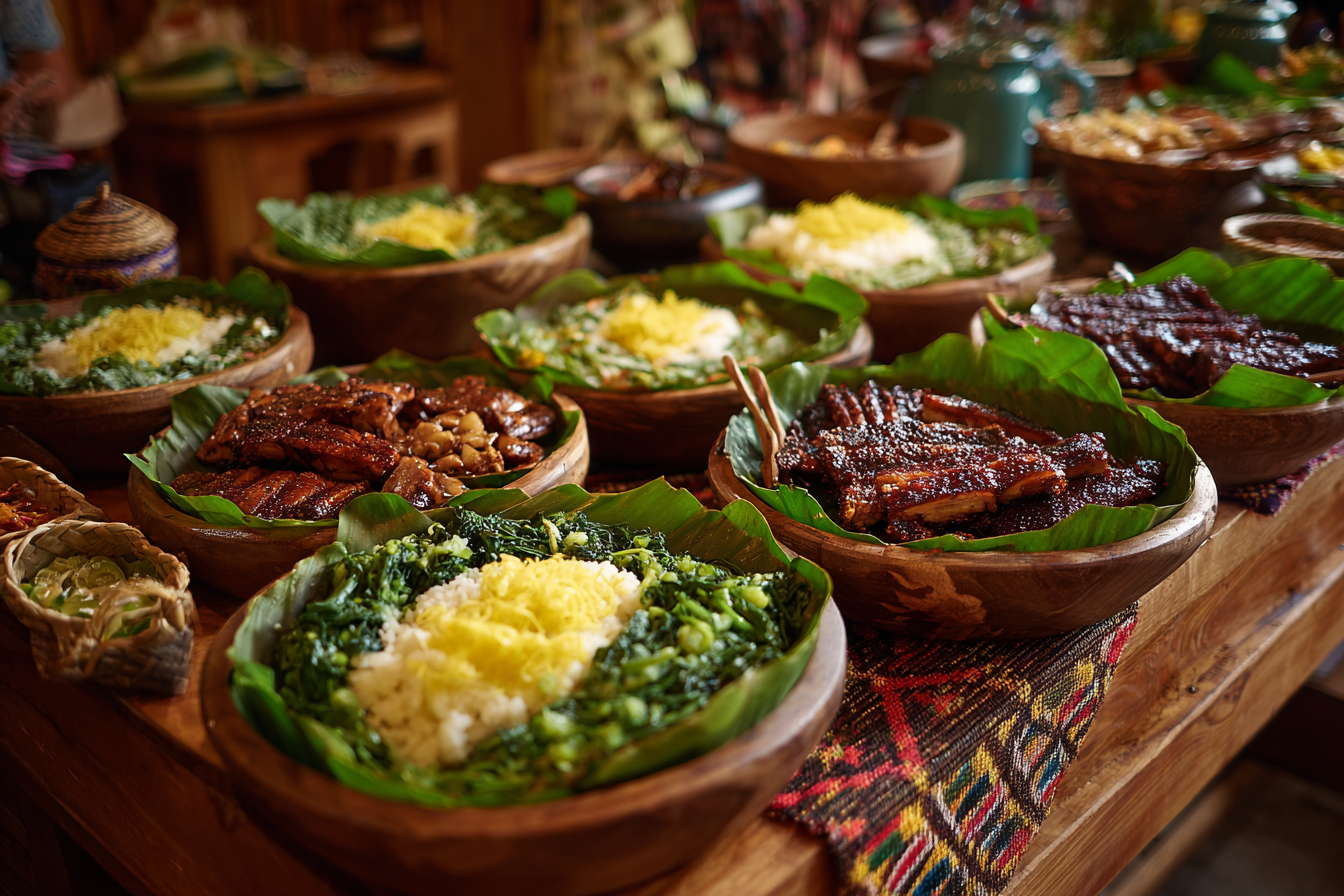Visiting Banaue, nestled in the heart of the Ifugao province in the Philippines, offers more than just breathtaking views of the iconic rice terraces. It also provides a unique opportunity to dive into the rich culinary traditions of the Ifugao people. Their cuisine echoes centuries of culture, history, and connection to the land. Sampling the local food is not just about flavor—it’s a gateway to understanding the region’s lifestyle, customs, and deep respect for nature. This guide will take you on a flavorful journey through Banaue’s local cuisine, showcasing traditional dishes, key ingredients, and the best places to enjoy authentic meals during your trip.
Introduction to Ifugao Culinary Traditions
The culinary heritage of Banaue is deeply intertwined with the agricultural practices and natural bounty of the Ifugao region. Traditionally, Ifugao cooking relies heavily on what the land provides—chiefly rice, fresh vegetables, native herbs, and locally raised animals. Food preparation methods are largely centered around communal meals, often cooked over open flames or wood-fired stoves. This traditional approach ensures that each dish maintains authentic flavors, connecting past generations with the present.
Rice, of course, is the cornerstone of Ifugao meals, grown mostly on the world-famous Banaue Rice Terraces. Aside from steamed rice, sticky rice and rice wine play significant roles in meals and rituals. Other indigenous ingredients such as root crops, wild mushrooms, and various leafy greens can be found in many dishes, reflecting the diversity of local flora. Preservation methods like smoking and drying meat are also practiced, showcasing the resourcefulness of Ifugao cooking techniques.
Popular Dishes and Ingredients
When it comes to local dishes, Banaue boasts several unique and flavorful options that every visitor should try. Here are some popular dishes and key ingredients you’ll encounter:
- Binungor: This is a native dish made by cooking pork or chicken with fragrant local leaves such as guava or young bamboo shoots, wrapped in banana leaves. The steaming process results in tender, flavorful meat infused with herbal aromas.
- Pinikpikan: A traditional Ifugao chicken dish where the chicken is gently beaten before cooking to enhance its flavor and tenderness, then boiled with herbs and vegetables. It’s often enjoyed during special occasions and offers a unique flavor profile due to its distinct preparation method.
- Tapuey Rice Wine: This fermented rice wine is a staple in Ifugao festivities. It is made from native varieties of glutinous rice and serves both as a drink and a cooking ingredient in some recipes.
- Root Crops and Vegetables: Sweet potatoes, taro, and gabi (taro bulbs) form a significant part of daily meals. They are often boiled, roasted, or incorporated into soups and stews, providing earthy flavors and natural sweetness.
- Wild Mushrooms and Herbs: Foraged from nearby forests, wild mushrooms add an intense, earthy flavor to dishes, while herbs like lemongrass and ginger are used to season food naturally.
Street Food vs. Home-Cooked Meals
Experiencing Banaue’s local cuisine means deciding whether to indulge in the lively, bustling street food scene or savor traditional home-cooked meals. Both offer thrilling culinary adventures but present different insights into the food culture.
Street Food: The small markets and roadside stalls of Banaue are treasure troves of quick, flavorful bites. Here, you can sample grilled meats, fresh vegetable stalls, sticky rice desserts, and other simple delicacies. Street food meals are often freshly prepared and serve as a social hub for locals and visitors alike, giving you a taste of daily life in a casual setting.
Home-Cooked Meals: For a deeper and more intimate culinary experience, home-cooked meals provide a closer look at traditional recipes and cooking methods, typically passed down through generations. Staying in local guesthouses or homestays often includes the chance to partake in these hearty meals, where sharing food is a symbol of friendship and respect. The slower pace of home cooking means richer, more complex flavors and a wholesome dining experience.
Best Restaurants and Local Eateries
While Banaue is a small town, it offers some excellent spots to enjoy authentic local dishes paired with warm Ifugao hospitality. Here are some of the best recommendations:
- Jasper’s Inn Restaurant: A favorite for tourists and locals, known for combining traditional Ifugao dishes with Filipino favorites. Try their Binungor and freshly brewed rice coffee.
- Banaue Café: Offers a cozy ambiance with dishes that highlight indigenous ingredients like root vegetables and native herbs. Their sticky rice desserts are particularly popular.
- Kubing Café and Restaurant: Known for serving fresh, locally sourced food, this restaurant focuses on community-based dining experiences with traditional presentations.
- Local Homestays: Various homestay operators offer home-cooked meals as part of their service, giving guests authentic tastes and cultural stories behind the food.
Food Festivals and Markets
To truly immerse yourself in the culinary culture, timing your visit to coincide with local food festivals or exploring the markets is ideal. Banaue and the Ifugao province host events where food takes center stage, celebrating harvests, traditions, and community.
- Ifugao Rice Terraces Festival: Held annually, this festival showcases the bounty of the rice terraces through food fairs and cooking demonstrations. It’s an excellent time to try various rice-based dishes and beverages.
- Banaue Public Market: A bustling hub every morning, offering fresh produce, local meat, exotic fruits, and street snacks. Here you can observe or sample fresh ingredients straight from the source.
- Ethnic Food Fairs: Occasional food fairs provide opportunities to taste specialty dishes made from wild forest ingredients, traditional desserts, and native drinks.
Dietary Tips for Travelers
If you’re planning to explore Banaue’s food scene, here are some tips to ensure a pleasant and safe culinary adventure:
- Respect Local Customs: Always ask before photographing or joining meals. Sharing food is an honored tradition, so embrace invitations with gratitude.
- Stay Hydrated: Ifugao cuisine can be hearty and the climate tropical. Drink plenty of water and consider trying rice wine moderately.
- Be Mindful of Ingredients: If you have allergies, let your hosts or restaurant staff know, as local dishes may contain unfamiliar herbs or fungi.
- Try Small Portions First: To ease your palate into new flavors, start with small servings of unfamiliar dishes before indulging fully.
- Consider Food Safety: Stick to reputable eateries or homestays. Opt for cooked rather than raw items when in doubt.
Discovering Banaue Through Flavor
Tasting Banaue’s local cuisine is much more than sampling dishes; it is an exploration of a culture deeply rooted in tradition and nature. From the rice terraces that sustain the community to the communal meals enjoyed among families and visitors, each bite tells a story of the Ifugao people’s resilience, resourcefulness, and respect for their environment. Whether you savor the smoky aroma of Binungor, the earthy richness of wild mushrooms, or the sweet warmth of Tapuey rice wine, you’ll leave Banaue with more than memories of stunning landscapes—you’ll carry the flavors of a remarkable heritage with you.







